Finding Masago: The Tiny Roe That’s Changing Modern Sushi
Masago is the small, orange-colored fish eggs (roe) harvested from capelin fish that you’ll find topping sushi rolls and adding bursts of flavor to Japanese cuisine worldwide.
Quick Facts About Masago:
- Source: Capelin fish (Mallotus villosus) from cold northern waters
- Appearance: Tiny, naturally pale yellow eggs often dyed orange, red, or green
- Taste: Mild, briny-sweet flavor with a subtle “pop” texture
- Uses: Sushi garnish, poke bowl topping, sauce ingredient
- Nutrition: Low calorie, high protein, rich in vitamin B12 and omega-3s
- Cost: More affordable alternative to tobiko (flying fish roe)
For avid food travelers seeking authentic culinary experiences, masago represents a perfect entry point into Japanese roe. This tiny ingredient has journeyed from traditional sushi bars to fusion restaurants across the globe, offering an accessible way to explore umami-rich flavors without the premium price tag of caviar.
The word “masago” literally means “sand” in Japanese – a fitting name for these granular eggs that add both visual appeal and textural contrast to dishes. Whether you’re finding it for the first time at a local sushi restaurant or planning to incorporate it into your own culinary trips, understanding masago opens doors to countless flavor possibilities.
As one sushi chef noted: “My kids love sushi, but one of my daughters has always been captivated by masago, always asking for extra with her California rolls when she was small.”
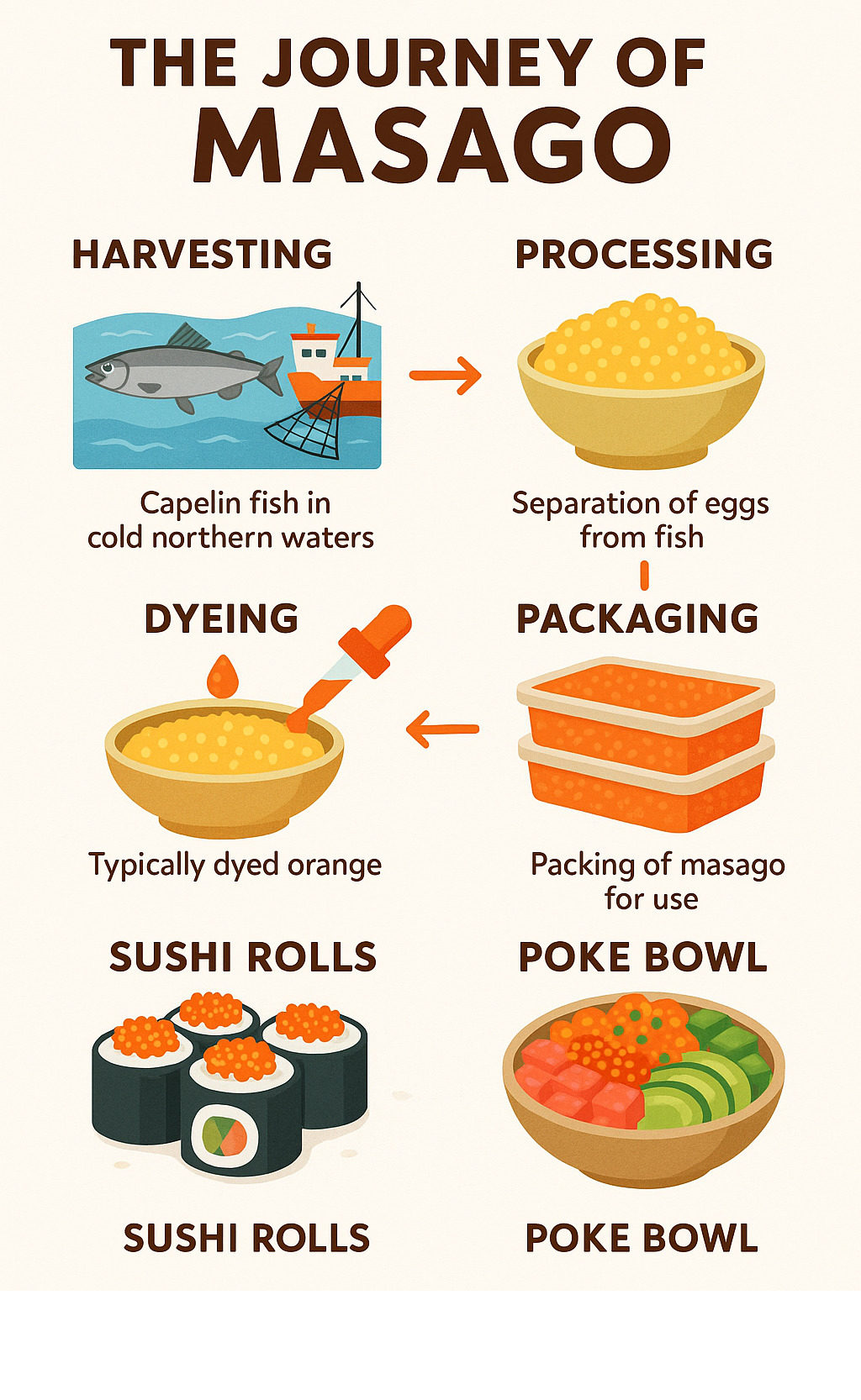
What Is Masago?
The word “masago” comes from the Japanese term meaning “sand,” and once you see these tiny, granular fish eggs, you’ll understand why. This poetic name captures how these delicate pearls look scattered across your favorite sushi roll.
Masago is the roe (fish eggs) from capelin fish, scientifically known as Mallotus villosus. These small, silvery fish are only about 4-8 inches long but incredibly important to marine ecosystems and our dinner plates.
Capelin swim in the chilly waters of the North Atlantic, North Pacific, and Arctic Oceans. Female capelin carry anywhere from 6,000 to 30,000 tiny eggs each – that’s a lot of potential masago!
Here’s something that might surprise you: those bright orange eggs on your California roll don’t start out that color. Natural capelin roe is actually pale yellow or translucent. The vibrant orange, red, or green colors come from food-safe dyes added during processing.
Timing of harvesting makes all the difference. Capelin are caught just before they spawn, when their eggs are perfectly developed. This precise timing ensures that ideal texture and flavor that makes masago so special.
Masago is actually a byproduct of the larger capelin fishing industry. About 80% of caught capelin becomes fishmeal and fish oil for animal feed, while only 20% goes toward producing the roe we enjoy. This makes masago both sustainable and cost-effective.
The Role of Masago in Japanese Cuisine
In traditional Japanese cooking, masago plays several important roles. You’ll often see it in gunkan-maki, those “battleship” style sushi pieces where seaweed creates a cup around seasoned rice, perfectly holding the delicate roe.
The California roll really put masago on the map for Western diners. Those tiny orange pearls coating the outside don’t just look appealing – they add subtle crunch and mild briny flavor that perfectly balances the creamy avocado and sweet crab inside.
Japanese chefs love masago because it’s versatile. They might mix it with wasabi for spice, combine it with squid ink for dramatic black coloring, or leave it natural for understated presentation. When used as a garnish on Sashimi, masago improves the fish’s flavor without overwhelming it.
The beauty of masago lies in its ability to add both visual drama and subtle flavor to dishes, making it essential in both traditional and modern Japanese cuisine.
Harvesting & Production of Masago
The story of masago begins in the icy waters of the North Atlantic and Pacific, where capelin fish gather for their annual spawning ritual. Unlike many fish species, capelin spawn on coastal gravel beaches, making them accessible to commercial fisheries.
Timing is everything when harvesting quality masago. The prime season runs from April through July, when female capelin are heavy with eggs but haven’t yet spawned. This narrow window is crucial – too early and the eggs aren’t developed; too late and you’ve missed your chance.
The world’s best masago comes from Iceland, Norway, and Canada. These regions maintain strict fishing standards and have cold, clean waters that produce superior roe quality.
Once capelin are brought aboard, time becomes critical. The roe must be extracted quickly to maintain freshness. Processing begins with salting, which preserves the eggs and improves flavor, followed by pasteurization – gentle heat treatment that makes masago safe for raw consumption while keeping that satisfying “pop.”
The coloring process gives masago its Instagram-worthy appearance. Those vibrant orange, red, black, and green hues come from food-safe dyes applied during processing. Natural color is pale yellow – pretty, but not as eye-catching as the bright orange we typically see.
One of the best things about masago is its low mercury status. Since capelin are small fish feeding mainly on plankton and tiny crustaceans, they don’t accumulate mercury levels found in larger predatory fish.
Sustainability Snapshot for Masago
The sustainability story of masago is nuanced. While these tiny gems seem harmless, the World Wildlife Fund has raised concerns about capelin fishing practices and their broader marine ecosystem impact.
Capelin aren’t just a source of masago – they’re cornerstone species in cold-water marine food webs. Cod, seals, whales, and seabirds depend on capelin as primary food. When capelin populations fluctuate, effects ripple through entire ecosystems.
By-catch remains a challenge in capelin fisheries, sometimes accidentally capturing other marine life. However, many fisheries have implemented quota management systems to prevent overfishing and maintain sustainable harvest levels.
Interestingly, masago production is essentially a byproduct. About 80% of harvested capelin becomes fishmeal and fish oil, while only 20% becomes roe. This maximizes use of each fish caught, reducing overall waste.
For sustainable seafood choices, Seafood Watch research on capelin offers updated guidance on environmentally responsible fishing regions and methods.
Masago vs. Tobiko vs. Caviar
When you’re exploring fish roe, it’s easy to get confused by all the tiny, colorful eggs adorning your sushi. Let’s clear up the mystery between masago, tobiko, and caviar – three types of roe that might look similar but come from completely different fish and offer unique experiences.
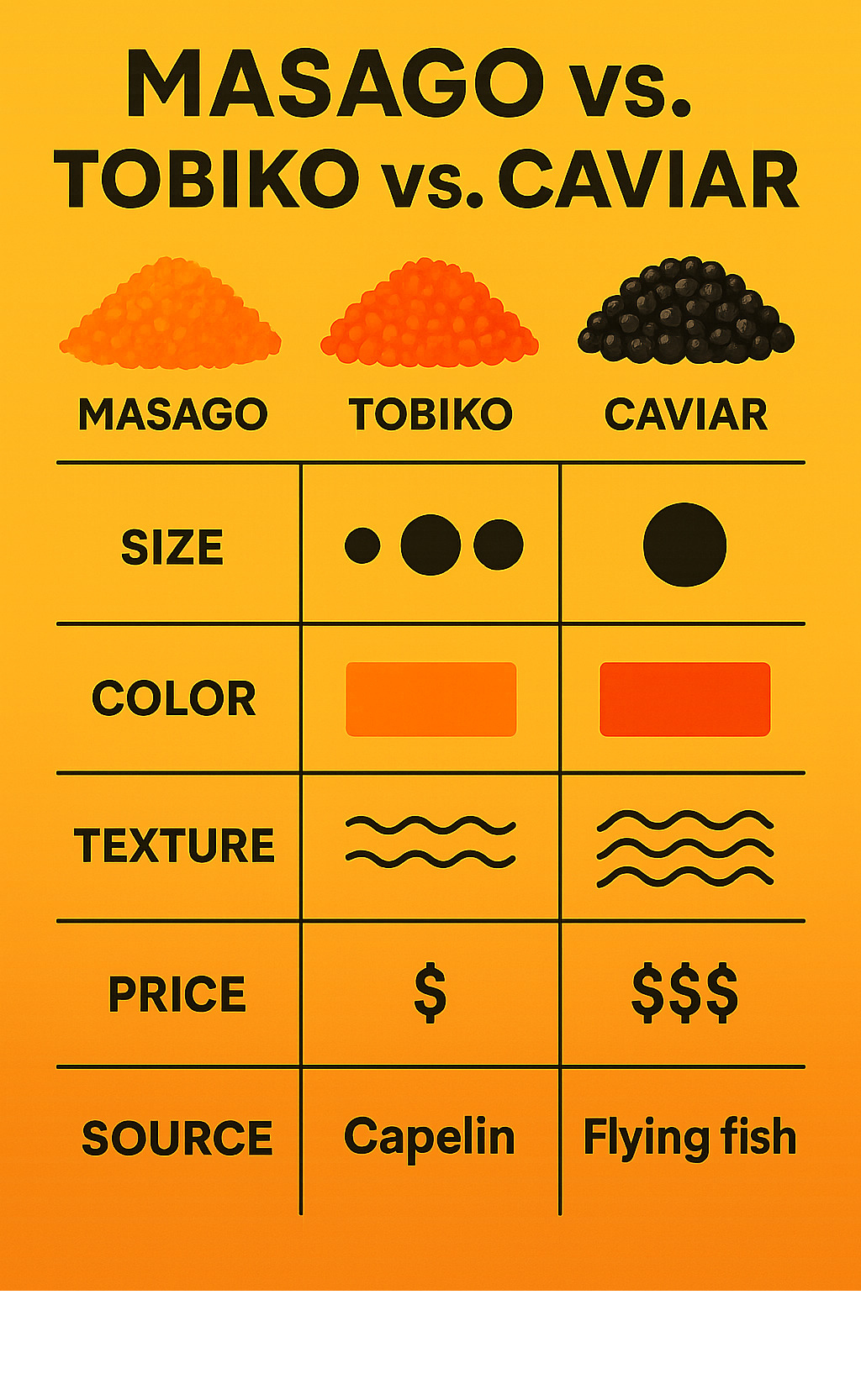
Masago comes from capelin, a small fish in the smelt family that swims in cold northern waters. The eggs are tiny – about 0.5-0.8mm – and naturally pale yellow before being dyed those vibrant colors we see in restaurants. When you bite into masago, you’ll notice a soft pop and a mild, subtly briny-sweet flavor that doesn’t overpower other ingredients.
Tobiko, on the other hand, comes from flying fish and sits in the premium category. These eggs are similar in size to masago but pack a firmer crunch and a more pronounced smoky flavor. The natural orange-red color is more vibrant than capelin roe, though tobiko is also sometimes dyed for variety.
Caviar is the luxury option – these large, creamy eggs from sturgeon can measure 2-4mm across. True caviar offers a buttery, complex flavor that melts on your tongue rather than popping. The natural colors range from gray to black, and the price reflects its status as a delicacy.
| Characteristic | Masago | Tobiko | Caviar |
|---|---|---|---|
| Source Fish | Capelin (smelt family) | Flying fish | Sturgeon |
| Egg Size | 0.5-0.8mm (smallest) | 0.5-0.8mm | 2-4mm (largest) |
| Natural Color | Pale yellow/translucent | Orange-red | Gray to black |
| Texture | Soft pop, less crunchy | Firm pop, crunchy | Creamy, buttery |
| Flavor | Mild, subtly briny-sweet | Smoky, more pronounced | Rich, complex, buttery |
| Price Range | $15-30 per pound | $25-50 per pound | $100-300+ per ounce |
| Common Uses | Sushi garnish, fusion dishes | Premium sushi, fine dining | Luxury appetizers, haute cuisine |
The price differences tell the whole story. While caviar costs $100-300+ per ounce and tobiko runs $25-50 per pound, masago comes in at a wallet-friendly $15-30 per pound. This makes it possible for everyday sushi lovers to enjoy the roe experience without breaking the bank.
Why Many Chefs Choose Masago
Restaurant chefs have fallen in love with masago for reasons that go far beyond its budget-friendly price. The cost-effective nature of masago means they can add visual appeal and textural interest to regular menu items, not just special occasion dishes.
The dye versatility of masago opens up creative possibilities that natural roe simply can’t match. Need dramatic black roe for a Halloween-themed roll? Want festive red eggs for a holiday presentation? Green masago mixed with wasabi creates stunning visual impact that gets diners reaching for their phones. This adaptability has made masago a star player in fusion cuisine, where Instagram-worthy presentation matters as much as taste.
Perhaps most importantly, the subtle brine of masago makes it the perfect supporting actor rather than the scene-stealer. Unlike tobiko’s assertive smokiness or caviar’s rich complexity, masago improves other flavors without competing for attention. This quality makes it ideal for fusion dishes where balance is everything – think masago-topped avocado toast or sprinkled over delicate sashimi.
Many chefs also appreciate how forgiving masago is to work with. Its mild flavor means it won’t clash with unexpected ingredient combinations, making it perfect for creative experimentation. Whether you’re adding it to a traditional California roll or incorporating it into a modern poke bowl, masago adapts beautifully to whatever culinary trip you have in mind.
Flavor Profile & Culinary Uses of Masago
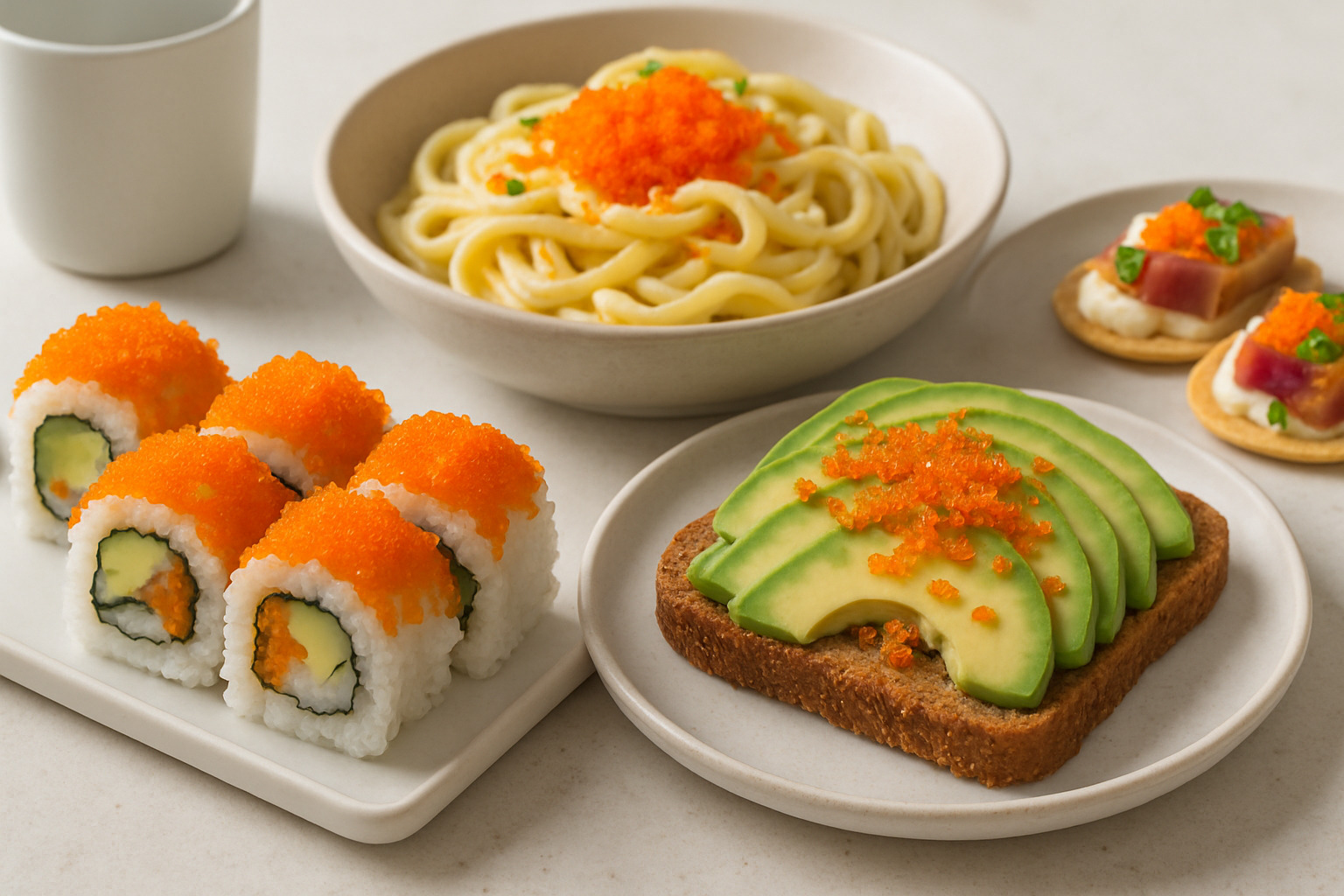
When you first taste masago, you’ll notice something delightfully unexpected. Instead of overwhelming fishiness, these tiny eggs deliver a briny-sweet flavor that dances between ocean and sweetness. The texture is equally charming – each egg provides a soft pop that releases flavor gently across your palate.
This mild character makes masago a culinary chameleon. It doesn’t shout for attention – instead, it whispers flavor improvements that make everything taste better. That’s the magic of umami that masago delivers.
Think of masago as a flavor amplifier rather than dominator. On sushi, it doesn’t mask delicate fish underneath. Instead, it brings out natural sweetness while adding subtle oceanic notes.
Modern chefs have found masago works beautifully beyond the sushi counter. Stirred into creamy sauces, it adds visual drama and flavor bursts. Poke bowls benefit from the textural contrast and flavor boost masago provides. Even avocado toast becomes Instagram-worthy with a generous sprinkle of these colorful eggs.
Different colored varieties bring their own personality. Wasabi masago delivers gentle heat, black masago (improved with squid ink) adds earthy depth, and red masago tends to be the gentlest option for newcomers.
One favorite upscale application is masago as oyster garnish. The contrast is brilliant – smooth, briny oyster meets tiny, popping eggs.
Creative Street-Food-Style Recipes with Masago
Street food has welcomed masago with creative minds. Sushirritos – oversized sushi rolls eaten like burritos – often showcase masago inside and out, delivering layers of texture and flavor.
Masago-mayo drizzle has become fusion kitchens’ secret weapon. This creamy, orange-speckled sauce combines rich mayonnaise with masago’s pop and brine. Try it on grilled fish, vegetable tempura, or even french fries. The recipe is simple: fold masago into mayonnaise with lime juice and garlic powder.
Noodle-cart style bowls have also found masago’s charm. Whether slurping ramen, pho, or fusion noodle creations, a final sprinkle adds visual pop and unexpected flavor dimension.
The beauty of these applications is their accessibility. You don’t need sushi chef training to sprinkle masago on homemade creations.
For more inspiration on reimagined traditional ingredients, our World Cuisine Exploration guide offers plenty of fusion ideas.
Nutrition, Benefits & Health Considerations
Nutritionally, masago punches above its weight class. These tiny pearls deliver 40 calories per ounce with impressive protein and essential nutrients.
The protein content is where masago shines. With 6 grams of complete protein per ounce, you’re getting all essential amino acids – roughly the same as a medium chicken egg, making masago excellent for boosting protein without excessive calories.
The real nutritional superstars are omega-3 fatty acids. These beneficial fats support heart health, brain function, and reduce inflammation. For travelers who might not always access fatty fish, masago offers convenient essential nutrients.
Most impressive is vitamin B12 content – a single ounce provides 47% of Daily Value. This vitamin is crucial for nerve health, red blood cell formation, and DNA creation. Since B12 is mainly in animal products, masago is valuable if you’re reducing meat consumption.
Selenium content provides 16% of Daily Value per ounce. This trace mineral acts as a powerful antioxidant, supporting immune system and thyroid health.
Scientific Insights on Masago’s Nutrients
Research on protein satiety shows high-quality protein like masago’s can help you feel satisfied, potentially supporting weight management. Studies found getting 25% of calories from protein can cut cravings in half.
Anti-inflammatory omega-3 fatty acids in masago have been extensively studied. Regular consumption is linked to reduced heart disease risk, better brain function, and lower inflammation markers. Scientific research on selenium benefits demonstrates this mineral’s role in protecting against oxidative stress.
One of the best safety aspects is masago’s low mercury content. Since capelin feed low on the food chain, they don’t accumulate mercury levels found in larger predatory fish.
Potential Downsides & Allergy Alerts
The main consideration is sodium content – a tablespoon contains about 240 milligrams, roughly 10% of FDA’s recommended 2,300 milligrams daily. If watching blood pressure or following low-sodium diets, factor this into daily totals.
The FDA sodium guidelines recommend limiting sodium intake to reduce cardiovascular disease risk.
Allergic reactions can occur, particularly with existing seafood allergies. The protein vitellogenin can trigger reactions from mild skin irritation to respiratory symptoms. Check with your doctor if you have known seafood allergies.
Some commercial masago contains additives like MSG, high-fructose corn syrup, and artificial preservatives. Reading labels helps find products with minimal additives.
For expectant mothers, masago is generally safe thanks to low mercury and pasteurization. However, moderation is key – limiting to two or three servings weekly aligns with pregnancy seafood guidelines.
Buying, Storing & Serving Masago Safely
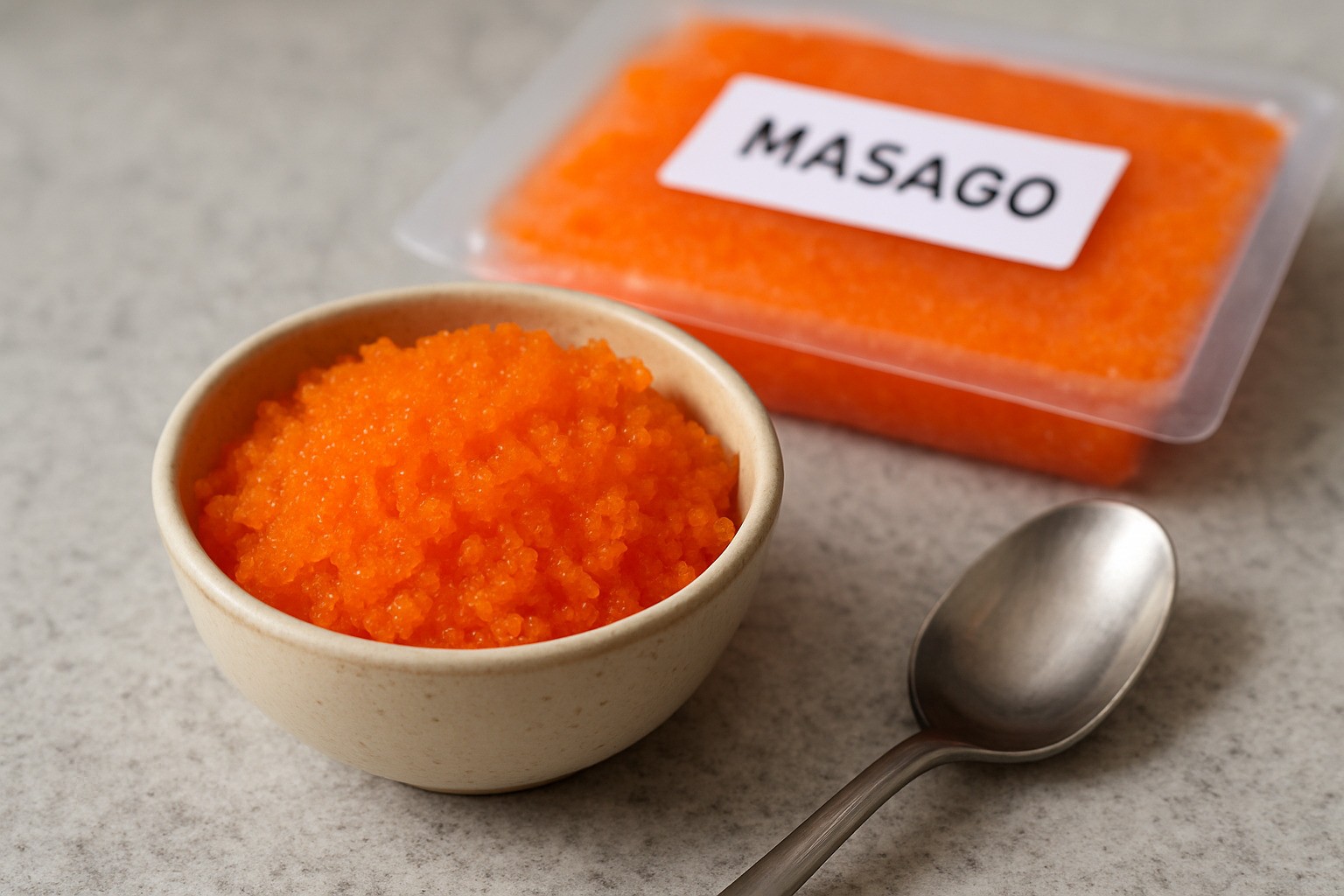
Finding quality masago has become much easier in recent years. You’ll find it in the frozen seafood section of Asian markets, specialty fish stores, and increasingly at mainstream grocery stores. The choice between frozen and chilled masago often depends on your plans – frozen varieties maintain their quality beautifully and tend to be more budget-friendly for home cooking trips.
When selecting masago, your eyes are your best guide. Quality roe displays bright, vibrant colors without any dullness or grayish appearance that might suggest it’s past its prime. The individual eggs should look separate and distinct, not clumped together in a way that suggests poor handling or age.
Price-wise, expect to invest $15-30 per pound for good quality masago – a reasonable cost compared to tobiko’s $25-50 per pound price tag. While this might seem steep at first glance, a little goes a long way. A single tablespoon can transform multiple sushi rolls or add that special pop to several dishes.
For environmentally conscious food lovers, look for eco-labels or sustainability certifications on packaging. More producers are sharing information about their fishing methods and environmental commitments, making it easier to make choices that align with your values.
Masago Storage FAQs
Proper storage makes all the difference in maintaining masago’s delightful texture and fresh flavor. Once opened, fresh masago needs to live in your refrigerator at 0-4°C (32-39°F) and should be enjoyed within one week. The secret is keeping it in an airtight container to prevent contamination and preserve that perfect moisture level.
For longer-term storage, masago freezes beautifully for up to 6 months. Here’s a pro tip from experienced home cooks: portion it before freezing. Divide your masago into small containers or even ice cube trays, so you can thaw exactly what you need without waste.
The golden rule with masago is never refreeze thawed roe. Those delicate egg structures don’t handle repeated freeze-thaw cycles well, resulting in a disappointing mushy texture that loses the signature pop we all love. Once thawed, plan to use your masago within 3-4 days for the best experience.
When it’s time to serve, keep your masago chilled until the very last moment. Minimizing room temperature exposure helps maintain both food safety and that pleasant burst of flavor that makes masago such a delightful addition to any dish.
Frequently Asked Questions about Masago
Is masago safe for people with seafood allergies?
Masago presents a complex situation for seafood allergies. Since masago comes from capelin fish, it contains fish proteins that can trigger reactions in people with fish allergies. The allergenic proteins in fish roe are similar to those in fish meat.
However, if you specifically have shellfish allergies (shrimp, lobster, crab), you might be able to enjoy masago safely. Fish and shellfish allergies are different categories involving different proteins.
Always consult with an allergist before trying masago if you have any seafood allergies.
Can I eat masago during pregnancy?
Masago is generally considered safe during pregnancy for two main reasons. First, mercury content is extremely low since capelin are small fish feeding on plankton. Second, commercial masago undergoes pasteurization, eliminating harmful bacteria while preserving texture and flavor.
Moderation is still key – most providers recommend limiting masago to 2-3 servings weekly. Also consider that masago is high in sodium.
Check with your doctor about specific dietary needs during pregnancy.
How does masago stay bright orange?
Natural masago isn’t orange – fresh capelin roe is pale yellow or translucent. The bright orange comes from food-safe dyes (typically FD&C Yellow #6 and Red #40) applied during processing.
The dyeing happens after harvesting and curing, ensuring even color distribution. This isn’t just aesthetic – coloring helps distinguish masago from other roe types.
Some premium products use natural colorants like beet juice or squid ink. The coloring doesn’t affect flavor or nutritional value.
Conclusion
Our exploration of masago has taken us on a delicious journey from the icy waters where capelin swim to the vibrant sushi rolls that grace our plates. This tiny ingredient perfectly captures how food connects cultures and creates new traditions – changing from a simple fish roe into a beloved element of modern cuisine.
The beauty of masago lies in its accessibility. Unlike expensive caviar or even pricier tobiko, masago invites everyone to experience the unique pleasure of roe without breaking the bank. Its mild, briny-sweet flavor and satisfying pop make it an ideal introduction to fish eggs, while its impressive nutritional profile – packed with protein, omega-3s, and vitamin B12 – means you’re nourishing your body while treating your taste buds.
Responsible enjoyment is key when it comes to masago. By choosing products from sustainable fisheries and consuming them in moderation, we can savor this oceanic treat while supporting healthy marine ecosystems. The good news is that masago’s low mercury content makes it one of the safer seafood choices for regular enjoyment.
For adventurous food lovers, masago opens doors to countless culinary possibilities. Whether you’re sprinkling it on avocado toast for breakfast, mixing it into pasta sauces for dinner, or simply enjoying it on your favorite sushi roll, this versatile ingredient adapts beautifully to both traditional and fusion applications.
The story of masago reminds us that some of the most exciting culinary findies come in small packages. From street food innovations to high-end restaurant creations, this humble capelin roe continues to inspire chefs and home cooks alike to explore new flavor combinations and presentations.
As you continue your own culinary trips, understanding ingredients like masago deepens every dining experience. Whether you’re traveling to a new city or exploring your local food scene, knowing the stories behind what you eat transforms every meal into a cultural exchange.
Ready to find more fascinating ingredients and dining experiences? Our team at The Dining Destination continues to uncover the stories behind the foods that bring us together. Explore our Best Culinary Experiences guide for more insights into the wonderful world of global cuisine, where every bite tells a story worth sharing.

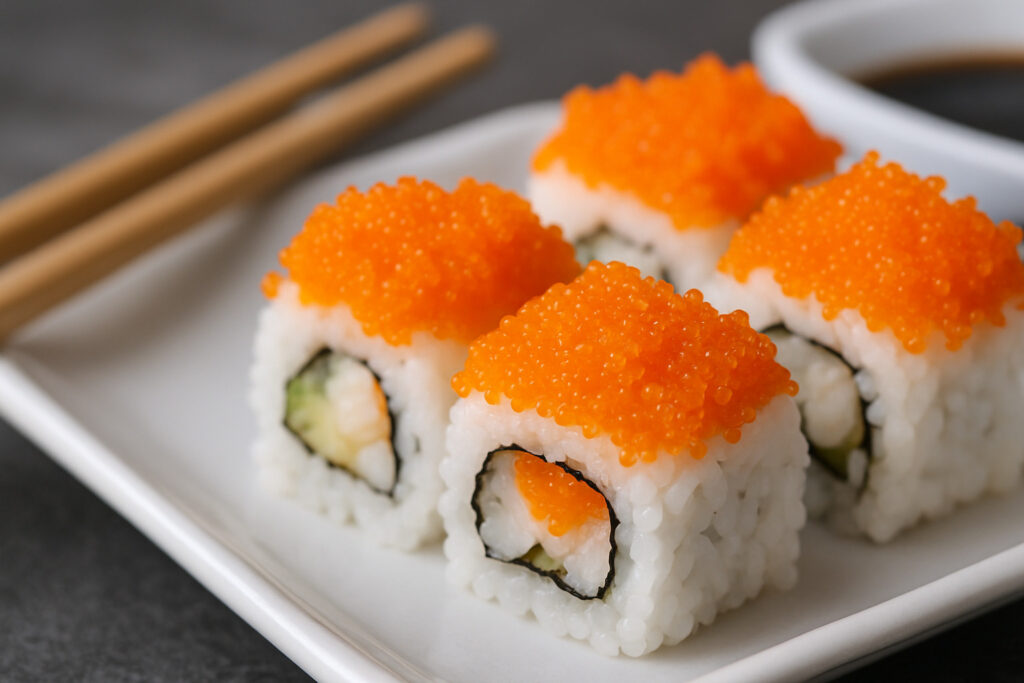






3 thoughts on “Beginner’s Guide to Masago: What It Is and How It’s Used”
Pingback: The Complete Guide to Rice Noodles: Types, Uses, and Tips - The Dining Destination
Pingback: The Ins and Outs of Monkfish: What You Need to Know - The Dining Destination
Pingback: Everything You Need to Know About Tahini - The Dining Destination
Comments are closed.